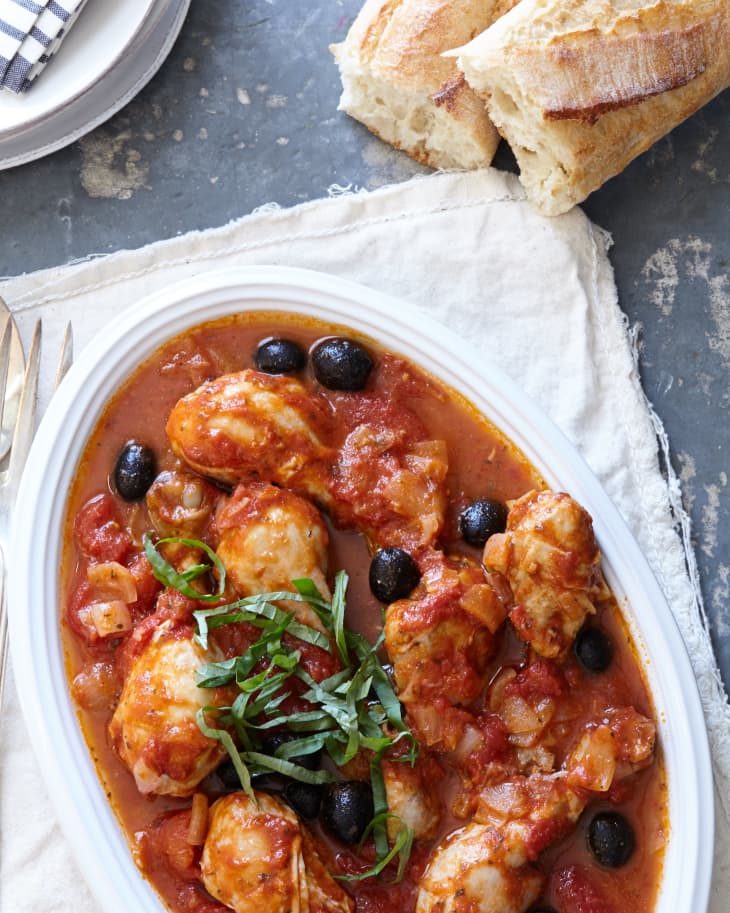Recipe: 30-Minute Pressure-Cooker Cacciatore Chicken

Can you bake or slow-cook frozen chicken? Nope … but you can pressure-cook it! Toss rock-hard frozen pieces of chicken into the pressure cooker and serve fall-off-the bone flavorful meat in less than 30 minutes.
Slow-cooking, stovetop simmering, or oven braising frozen chicken will keep it in the “danger zone,” (temperatures between 40°F and 140°F) long enough for the meat to host a stomach-wrenching bacteria party. Pressure-cooking meat with this method shoots the frozen chicken quickly past this zone and neutralizes any stragglers.
According to the USDA, any raw meat and poultry that’s been in the “danger zone” too long has allowed bacteria to multiply and grow enough to produce toxins. In addition to the bacteria, it’s those toxins that cause foodborne illnesses. Although bacteria is obliterated by the time the food boils, the heat-resistant toxins cannot be destroyed by the cooking process (even a low-and-slow eight-hour-long process), making even the fully cooked meat that has lingered in the danger zone too long unsafe to eat.
To pressure-cook chicken from frozen, you’ll need to make four adjustments to the recipe: boil it, adjust the pressure-cooking time, expect delays, and check the internal temperature.
Covering the frozen chicken with liquid ensures the heat will be transferred into most of the meat in the least amount of time. Making that cooking liquid flavorful will impart extra seasoning to the meat as well.
Increase the recommended pressure-cooking time for that cut of meat 50 percent or more. (In this case, bone-in chicken pieces usually require 10 minutes of pressure-cooking time, but going from frozen, that time is increased to 15 minutes.)
The pressure cooker will take slightly longer to reach pressure — that’s because the liquid that needs to boil inside in order to build pressure has a giant chicken ice cube in it. Depending on how much meat and liquid is in there, expect the cooker to take five to 10 minutes longer to build pressure. Some electric pressure cookers have a detector that turns off the cooker if it doesn’t reach pressure in a set amount of time. If this happen,s simply turn off the cooker, turn it back on, and reprogram the cooking time.
Lastly, to make sure that the right amount of heat got all the way to the middle of the chicken, slip a meat thermometer down to the bone and check that the internal temperature has reached 165°F.
Using fresh, not frozen, chicken? Make this pressure-cooker cacciatore chicken recipe the same way, but cut down the pressure-cooking time to 10 minutes.
30-Minute Cacciatore Chicken
Serves 4 to 6
Nutritional Info
Ingredients
- 1 cup
salt-free chicken stock
- 1 teaspoon
salt (withhold if using salted stock)
- 1
bay leaf
- 6 to 8
bone-in chicken drumsticks (1 1/2 to 2 pounds, fresh or frozen), or a mix of drumsticks and thighs
- 1
medium yellow onion, roughly chopped
- 1 teaspoon
garlic powder
- 1 teaspoon
dried oregano
- 1
(28-ounce) can whole stewed tomatoes in purée
- 1/2 cup
black olives (about 2.5 ounces), pitted
Instructions
Preheat the pressure cooker (by pressing brown/sauté mode).
Add chicken stock, salt, and bay leaf and mix well. Then, in the following order, add chicken, onion, garlic powder, oregano, and tomatoes.
Close the lid and pressure-cook for 15 minutes at high pressure. When time is up, open the pressure cooker with slow normal release: Open the valve on the lid slowly, or if the valve only opens at full throttle, in small bursts.
Remove the lid, tilting it away from you. Mix the contents well, remove, and discard the bay leaf. If the meat isn't almost falling off the bones (it should be), take the internal temperature with a meat thermometer to ensure the chicken is at least 165°F.
Using a slotted spoon, arrange the chicken and tomatoes on a deep serving dish. Drizzle with cooking liquid and sprinkle with black olives before serving.
Reduce the cooking liquid and serve over chicken and cooked pasta.
